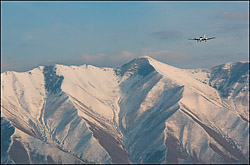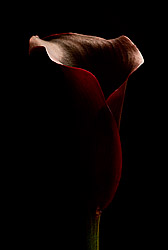Pre-visualization: One Milestone on the Photographic Journey (A Pep-Talk)
Text and photography copyright © Nathan Buck. All rights reserved.
Several years ago I pre-visualized what I thought would be a great shot. I imagined a shot with several large pots, overflowing with flowers. These pots of various sizes could be lined up on a sidewalk (or some other surface) against a "southwest look" red wall. Of course, in the thought that I imagined there was some perfect, soft light.
 Well, I might have been able to paint that shot, but I was not able to take that photograph – at least at the time that I imagined it. I did have some pots of various sizes that were overflowing with flowers. However, I did not have a red wall, I did not have a good sidewalk to put the pots on, and I was not willing to wait for the soft light that I wanted. That day was a wake-up call for me when thinking about pre-visualization. In fact, I would classify what I did that day as "day dreaming" instead of pre-visualization. Well, I might have been able to paint that shot, but I was not able to take that photograph – at least at the time that I imagined it. I did have some pots of various sizes that were overflowing with flowers. However, I did not have a red wall, I did not have a good sidewalk to put the pots on, and I was not willing to wait for the soft light that I wanted. That day was a wake-up call for me when thinking about pre-visualization. In fact, I would classify what I did that day as "day dreaming" instead of pre-visualization.
As with many other skills in photography, pre-visualization must be developed. Pre-visualization is a part of an overall journey in the art of photography. Just as other skills will develop to a point of usefulness, so will pre-visualization. Once to this point, pre-visualization will not be merely "day dreaming" about a certain photo that you want to take. Useful pre-visualization will take into account a use of all of the different tools and options that one might use in taking a certain photo. I have been involved in photography for many years, being very intensely involved for the last seven or eight years. I find that my ability to pre-visualize has really become useful in the last year or so.
Conditions & Environment
Successful pre-visualization will rely on knowledge of your subject and the conditions and environment in which it will be shot. Knowing when the light will be right on a certain subject is very helpful. Knowing if the wind is blowing at the time you will be shooting is also helpful. Conceiving of a winter shot while there is no snow on the ground may be a frustrating exercise. On the NPN discussion forum there have been repeated discussions in the past about whether or not a person will get better photos in an area on the first visit or a subsequent visit. Good photos can certainly happen on any visit to a location, but successful pre-visualization would happen on subsequent visits to an area. Photos taken on subsequent visits to a location at sunrise or sunset can be made much easier if the environment and conditions are known and one can pre-visualize a desired photo. I made several trips back to a location close to home where I was able to take photos of airplanes landing at a small airport (see image at right). My pre-visualization of these shots was much more useful on my second visit and each visit thereafter. desired photo. I made several trips back to a location close to home where I was able to take photos of airplanes landing at a small airport (see image at right). My pre-visualization of these shots was much more useful on my second visit and each visit thereafter.
If shooting in a studio setting, the conditions and environment that one shoots in can be more easily controlled and altered to fit the environment that you desire. However, it can still be very helpful to pre-visualize the lighting that is desired on a certain subject.
Familiarity with Your Subject
A photographer's familiarity with his or her subject can also mean varying levels of success when it comes to pre-visualization. I have spent the last couple of years immersed in flora photography and I am feeling confident about my ability to pre-visualize images in many situations. There are, however, many varieties of flowers that I photograph purely from an exploratory point of view, simply because I have not worked with them before. Different areas, photographing different birds or animals, and different elements in nature can all affect our ability to pre-visualize our intended subject in an image.
Tools
Knowledge of the tools that you will need to successfully capture your subject in its environment will also be necessary for pre-visualization. Using different focal length lenses, different shutter speeds, and different apertures will all affect the way a photo will turn out, and they are important factors in pre-visualization. In a studio environment, the lighting used for an image can also be considered a tool for creating the photo. For myself, pre-visualizing the lighting of a subject has taken longer to master than the other aspects of pre-visualizing have.
Some Success Stories
 Just this year, I saw a black calla lily at the florists and I visualized a shot with a black BG, very little light, and the top or front of the flower lined with light (see image at left). I was also able to see in my mind the placement of the light source, the composition, and the placement of my camera. I was thrilled when I was able to successfully take the photo that I had pre-visualized. Just this year, I saw a black calla lily at the florists and I visualized a shot with a black BG, very little light, and the top or front of the flower lined with light (see image at left). I was also able to see in my mind the placement of the light source, the composition, and the placement of my camera. I was thrilled when I was able to successfully take the photo that I had pre-visualized.
A short time ago I bought another flower at the florist, a lisianthus. This flower had some flowing pink petals and a stamen that was separate and uncluttered in the bottom of the bloom. I thought immediately about a shot that would focus on the stamen, using a very shallow DOF. I would need to be lined up parallel to the plane of the top of the stamen, but if I was able to line up well then I would be able to use the petals as a dreamy sea around the sharp stamen.
In another case this spring, my family and I were at our local home improvement store. I saw a beautiful cream-colored Tuberous Begonia. I immediately had two thoughts come to mind. One was that of the main bloom shot with a very wide aperture, the center of the flower in sharp focus, but the other areas softening into flowing lines. The other shot that I imagined was one where I would shoot with the aperture stopped down so that the layers of the petals in the bloom were the strength of the shot. Luckily, I was able to make each shot work.
Pre-visualization can be a useful tool, and in many situations, can help a photographer make better images. Pre-visualization will not take the place of spontaneous photo discovery and not every photo can or will be pre-visualized. However, pre-visualizing a photograph can inspire us to get to that lake before sunrise, buy that flower from the florist because we see the potential, or hike that hike one more time to try for that shot again. Pre-visualization is a just one more skill that we can add to our photo bag, and it takes persistence, just like the other ones. Good luck in your pursuit – I know I still need it in mine.
Comments on NPN nature photography articles? Send them to the editor.
Nathan Buck resides in Lehi, Utah with his wife, Charisma, and their three young sons. Nathan is a hobbyist photographer whose other favorite pastime is spending time with his family; he finds that photography allows him to do both. Nathan enjoys shooting a wide range of subjects, with flora being at the top of the list (at least for now, his wife says).


| 


